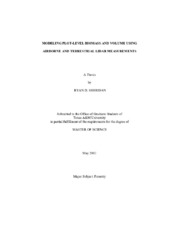| dc.description.abstract | The United States Forest Service (USFS) Forest Inventory and Analysis (FIA) program provides a diverse selection of data used to assess the status of the nation’s forested areas using sample locations dispersed throughout the country. Airborne, and more recently, terrestrial lidar (light detection and ranging) systems are capable of producing accurate measurements of individual tree dimensions and also possess the ability to characterize three-dimensional vertical forest structure. This study investigates the potential of airborne and terrestrial scanning lidar systems for modeling forest volume and aboveground biomass on FIA subplots in the Malheur National Forest, eastern Oregon. A methodology for the creation of five airborne lidar metric sets (four point cloud-based and one individual tree based) and four terrestrial lidar metric sets (three height-based and one distance-based) is presented.
Metrics were compared to estimates of subplot aboveground biomass and gross volume derived from FIA data using national and regional allometric equations respectively. Simple linear regression models from the airborne lidar data accounted for 15 percent of the variability in subplot biomass and 14 percent of the variability in subplot volume, while multiple linear regression models increased these amounts to 29 percent and 25 percent, respectively. When subplot estimates of biophysical parameters were scaled to the plot-level and compared with plot-level lidar metrics, simple linear regression models were able to account for 60 percent of the variability in biomass and 71 percent of the variation in volume. Terrestrial lidar metrics produced moderate results with simple linear regression models accounting for 41 percent of the variability in biomass and 46 percent of the variability in volume, with multiple linear regression models accounting for 71 percent and 84 percent, respectively. Results show that: (1) larger plot sizes help to mitigate errors and produce better models; and (2) a combination of height-based and distance-based terrestrial lidar metrics has the potential to estimate biomass and volume on FIA subplots. | en |


